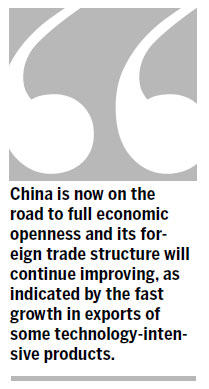Maintain hard-won advantages
Updated: 2012-11-23 08:16
By Mei Xinyu (China Daily)
|
||||||||

China's manufacturing and foreign trade sectors still enjoy a strong competitive edge in the global market
Despite a lingering sovereign debt crisis in the eurozone, the "fiscal cliff" in the United States, and a heavy cloud over the growth prospects of emerging markets, China's economy managed to pick up during its traditional "golden September and silver October" period after a months-long foreign trade slump.
Statistics show China's exports grew 11.6 percent year-on-year in October to $175.57 billion, 1.7 percentage points higher than the 9.9 percent growth in September. In the first 10 months of this year, the country's total import and export volume reached $3.1616 trillion, an increase of 6.3 percent year-on-year. The export value was $1.6709 trillion, an increase of 7.8 percent year-on-year. Against the backdrop of a steep decline in global trade, these are remarkable achievements.
The fact that China's trade conditions have turned better means its manufacturing and foreign trade sectors still enjoy a robust competitive edge in the global market. Despite facing ever-growing pressures from rising costs, China's diligent and well-trained labor force, its relatively complete industrial system, enormous domestic market and well-developed infrastructure, as well as improved public services and stable macroeconomic environment have all contributed to the success of domestic manufacturers and exporters in the global market. It is with such advantages that China's labor-intensive industries have achieved a tangible export growth rate even though they have been under huge pressures from rising costs. For example, from January to October, exports of shoes grew by 10.6 percent year-on-year, while furniture exports rose by 31.9 percent year-on-year and plastics by 39.7 percent.
China should by no means belittle the ongoing transfer of some of its labor-intensive manufacturing to Vietnam, India and other lower-cost neighbors, but it is also unnecessary for it to exaggerate the negative impacts the transfer will have on its overall export prospects. With a far smaller trade scale than China, these countries have a much weaker ability to curb any rise in costs. For example, the export volume of China's textiles was $240.55 billion, exceeding the total export value of any single Southeast or South Asian nation except India. Due to their much smaller economic scale and populations, most Southeast Asian nations are expected to witness a faster rise in labor costs in their processing trade than China has experienced over the past three decades. Compared with its neighbors, some of China's exporting hubs, such as the Pearl River and Yangtze River deltas, have maintained relatively stable labor costs over a long period due to the availability of labor in the vast inlands they border.
China is now on the road to full economic openness and its foreign trade structure will continue improving, as indicated by the fast growth in exports of some technology-intensive products. From January to October, China's exports of mechanical and electrical products grew 8.5 percent year-on-year, 0.7 percentage points higher than its whole export growth. Compared with its eastern, southeastern and southern regions, most of China's less-developed central and western regions, such as Chongqing municipality, Anhui, Henan, Sichuan and Jiangxi provinces, have all witnessed a faster export growth, a sign that China has achieved some substantial progress in realizing internal industrial transfer, promoting balanced development, extending the lifespan of its traditional labor-intensive industries and avoiding industrial hollowing.
China has shown greater determination to turn to domestic demand to bolster its economic development and develop itself into a consumption-driven economy. However, an economy of China's size is undercutting its development capability if it fails to pay due attention to foreign trade in the context of economic globalization. For China, the importance of foreign trade lies not only in how many external resources utilizes, or how many jobs it creates or how much output it produces. In the long run, China will likely forfeit its hard-won advantageous economic status in the international market if it cannot maintain its established trade advantages at a time when its economic growth is decelerating. The decline of Japan's once-prosperous home appliance and other pillar sectors, as a result of their failure to make sufficient efforts to maintain and expand their external market, should be a lesson to China.
The author is a researcher with the Chinese Academy of International Trade and Economic Cooperation, affiliated to the Ministry of
Commerce.
(China Daily 11/23/2012 page8)

 Relief reaches isolated village
Relief reaches isolated village
 Rainfall poses new threats to quake-hit region
Rainfall poses new threats to quake-hit region
 Funerals begin for Boston bombing victims
Funerals begin for Boston bombing victims
 Quake takeaway from China's Air Force
Quake takeaway from China's Air Force
 Obama celebrates young inventors at science fair
Obama celebrates young inventors at science fair
 Earth Day marked around the world
Earth Day marked around the world
 Volunteer team helping students find sense of normalcy
Volunteer team helping students find sense of normalcy
 Ethnic groups quick to join rescue efforts
Ethnic groups quick to join rescue efforts
Most Viewed
Editor's Picks

|

|

|

|

|

|
Today's Top News
Health new priority for quake zone
Xi meets US top military officer
Japan's boats driven out of Diaoyu
China mulls online shopping legislation
Bird flu death toll rises to 22
Putin appoints new ambassador to China
Japanese ships blocked from Diaoyu Islands
Inspired by Guan, more Chinese pick up golf
US Weekly

|

|






